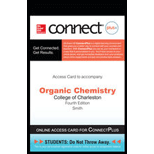
(a)
Interpretation:
The product for the given Diels-Alder reaction is to be drawn. The stereochemistry is to be indicated.
Concept introduction:
Diels-alder reaction is a cycloaddition reaction in which two molecules combine to form a new ring. In this type of reaction, syn addition takes place. It is a reaction between diene with a dienophile to yield a cyclohexene. The dienophile and the diene have syn stereochemistry.
(b)
Interpretation:
The product for the given Diels-Alder reaction is to be drawn. The stereochemistry is to be indicated.
Concept introduction:
Diels-alder reaction is a cycloaddition reaction in which two molecules combine to form a new ring. In this type of reaction, syn addition takes place. It is a reaction between diene with a dienophile to yield a cyclohexene. The dienophile and the diene have syn stereochemistry.
(c)
Interpretation:
The product for the given Diels-Alder reaction is to be drawn. The stereochemistry is to be indicated.
Concept introduction:
Diels-alder reaction is a cycloaddition reaction in which two molecules combine to form a new ring. In this type of reaction, syn addition takes place. It is a reaction between diene with a dienophile to yield a cyclohexene. The dienophile adds to one side of the diene, and diene adds to the one side of the dienophile. Thus, they have syn stereochemistry.
Want to see the full answer?
Check out a sample textbook solution
Chapter 16 Solutions
Organic Chemistry - Access (Custom)
- Draw the products of the following Diels-Alder reactions, and indicate the stereochemistry at all stereogenic centers.arrow_forwardDraw the product of each Diels–Alder reaction.arrow_forwardDraw a product of the following reaction. Indicate the stereochemistry of the Diels-Alder product.arrow_forward
- Draw the products of the following Diels–Alder reactions. Indicate stereochemistry where appropriate.arrow_forwardPredict products of each Diels-Alder reaction (including stereochemistry)arrow_forwardDraw the products of the following Diels–Alder reactions. Indicate stereochemistry where appropriate and show the pushing mechanism for a and barrow_forward
 ChemistryChemistryISBN:9781305957404Author:Steven S. Zumdahl, Susan A. Zumdahl, Donald J. DeCostePublisher:Cengage Learning
ChemistryChemistryISBN:9781305957404Author:Steven S. Zumdahl, Susan A. Zumdahl, Donald J. DeCostePublisher:Cengage Learning ChemistryChemistryISBN:9781259911156Author:Raymond Chang Dr., Jason Overby ProfessorPublisher:McGraw-Hill Education
ChemistryChemistryISBN:9781259911156Author:Raymond Chang Dr., Jason Overby ProfessorPublisher:McGraw-Hill Education Principles of Instrumental AnalysisChemistryISBN:9781305577213Author:Douglas A. Skoog, F. James Holler, Stanley R. CrouchPublisher:Cengage Learning
Principles of Instrumental AnalysisChemistryISBN:9781305577213Author:Douglas A. Skoog, F. James Holler, Stanley R. CrouchPublisher:Cengage Learning Organic ChemistryChemistryISBN:9780078021558Author:Janice Gorzynski Smith Dr.Publisher:McGraw-Hill Education
Organic ChemistryChemistryISBN:9780078021558Author:Janice Gorzynski Smith Dr.Publisher:McGraw-Hill Education Chemistry: Principles and ReactionsChemistryISBN:9781305079373Author:William L. Masterton, Cecile N. HurleyPublisher:Cengage Learning
Chemistry: Principles and ReactionsChemistryISBN:9781305079373Author:William L. Masterton, Cecile N. HurleyPublisher:Cengage Learning Elementary Principles of Chemical Processes, Bind...ChemistryISBN:9781118431221Author:Richard M. Felder, Ronald W. Rousseau, Lisa G. BullardPublisher:WILEY
Elementary Principles of Chemical Processes, Bind...ChemistryISBN:9781118431221Author:Richard M. Felder, Ronald W. Rousseau, Lisa G. BullardPublisher:WILEY





